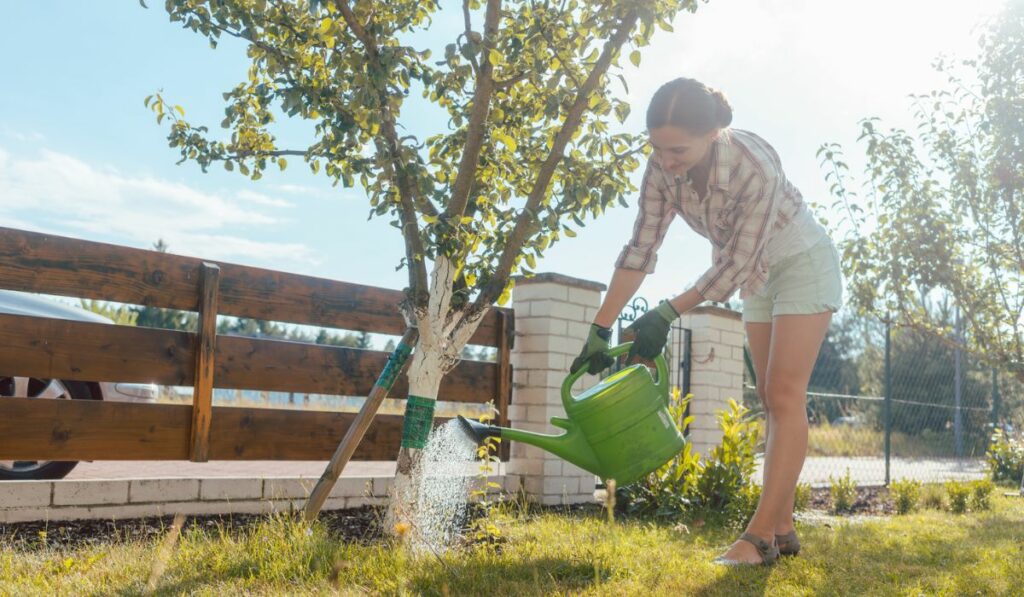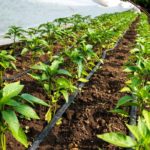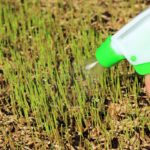Planting fruit trees in your yard can be quite rewarding when you get to harvest juicy, ripe fruits from your trees. Although each species has unique requirements, most fruit trees thrive in sunny regions, and water is crucial to the well-being and development of your plants. So, how should you water fruit trees to keep them in good shape?
Newly planted fruit trees need deep watering once a week during the growing season for optimal root development. Established fruit trees require less water; you can water them once every 10 to 14 days. Make sure to increase the watering frequency for potted fruit trees during hot summer months.
Regular watering is the most vital factor in ensuring the healthy growth of your fruit trees. Insufficient watering can encourage the development of shallow root systems that might not be strong or healthy enough to support the trees. Let’s take a look at how much water your fruit trees need as well as the signs that a tree isn’t getting enough water.
How Much Water Does a Fruit Tree Need Each Week?

As the seasons change, it’s critical to take care of your fruit trees by providing adequate watering and nutrient replenishment. Fruit trees often need a bucket of water weekly. However, you may need to water every two to three days in hot weather with little rain.
Newly planted trees require a gallon of water every seven days during the regular growing season, and this amount will naturally increase as the tree grows new leaves in the summer.
If there is rain, you don’t need to provide additional water, but use your best judgment because water availability and soil drainage can vary significantly from location to location.
As a tree ages, its roots establish, and the need for watering shifts from survival and growth to fruit harvest quality. Water-related stress can happen on either end of the spectrum. Overwatering or under-watering can lead to unhealthy plants or even death.
Fruit trees require a deep soak. Slowly water the soil so that it absorbs water at depths of 12-24 inches. Whether using an automatic irrigation system or a traditional watering can (on Amazon), occasionally let the soil dry out between watering sessions to avoid overwatering.
What Are the Signs of an Under-Watered Fruit Tree?
Trees use water to transport nutrients for optimal health. Lack of water can cause various adverse effects, including death. Below are some of the signs of an under-watered fruit tree:
- Wilted or curling leaves
- Brown leaf edges and tips
- Canopy discoloration
- Droopy leaves
- Leaves prematurely display fall colors (brown, red, or yellow)
What Are the Signs of an Overwatered Fruit Tree?
Do your trees look unhealthy despite watering them frequently? You could be showing them a little too much TLC. Overwatering your trees is as damaging as not providing enough water. Excess water can drown or suffocate your plant’s roots.
Here are some common signs of an overwatered fruit tree:
- The soil around the base of the tree stays continually damp or saturated
- The withering of new growth keeps it from flourishing and reaching maturity
- Discolored new growth at the tree’s trunk
- Healthy-looking leaves that are delicate and easily broken
Looking out for signs of overwatering in your garden or orchard and resolving the problem quickly will boost the health of your trees.
Young Fruit Trees vs. Mature Fruit Trees
Fruit tree water requirements vary widely based on the species and environment. Plants at different growth stages also have different water needs.
Young Fruit Trees

Water is essential for newly planted fruit trees as they establish themselves. Water thoroughly after planting to let the soil settle around the fruit tree’s base. After that, water only until the top two inches of soil are dry since soaking promotes trees to build deep, robust root systems.
Watering deeply once or twice weekly for the first two growing seasons keeps the fruit tree’s rootball moist and healthy.
Mature Fruit Trees
Although mature fruit trees require less water than young trees, they also need thorough soaking regularly to grow luscious fruit. Water needs can be met by gardeners or natural rains.
Mulching around fruit trees helps the soil retain moisture, whereas drip irrigation systems (on Amazon) help fruit trees to grow dense, robust roots and consume enough water to produce luscious fruit.
The Final Word
Fruit trees require wet but never soggy soil throughout the bloom season, when fruits are growing. Deciduous trees should be watered regularly until harvested, whereas evergreen species, such as citrus trees, require moist soil in the fall.
A fruit tree provides shade and yields abundant fresh fruit throughout the year. It also increases your property’s curb appeal and value.
Excess water is the leading cause of death for fruit trees in home gardens. And although the specific demands of fruit trees vary by species, you can ensure peak plant health and an abundant fruit harvest by the watering tips in this guide.








